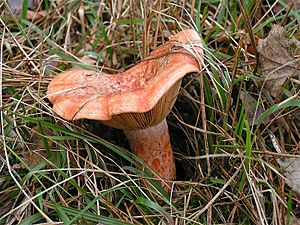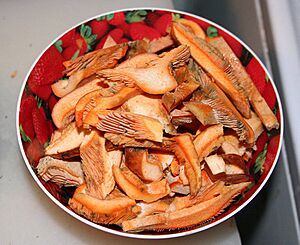Delicious milk cap facts for kids
Quick facts for kids Delicious milk cap |
|
|---|---|
 |
|
| Scientific classification | |
| Genus: |
Lactarius
|
| Species: |
deliciosus
|
| Synonyms | |
|
|
| Lactarius deliciosus | |
|---|---|
| Mycological characteristics | |
| gills on hymenium | |
| cap is depressed | |
| hymenium is decurrent | |
| stipe is bare | |
| spore print is tan | |
| ecology is mycorrhizal | |
| edibility: edible | |
Lactarius deliciosus, often called the saffron milk cap or red pine mushroom, is a very well-known type of mushroom. It belongs to a large group of mushrooms called Lactarius. You can find it in Europe, and it has also spread to other countries. It usually grows near conifer trees like pines.
Contents
How it Got its Name
This mushroom was first officially described by a famous scientist named Carl Linnaeus in 1753. He gave it the name Agaricus deliciosus. The word deliciosus comes from Latin and means "tasty". Linnaeus might have thought it tasted good, or he might have confused it with another tasty mushroom.
Later, in 1821, another scientist named Samuel Frederick Gray moved it to its current group, called Lactarius.
People call this mushroom by many names around the world. In English, it's often called saffron milk cap, red pine mushroom, or just pine mushroom. In North America, it's sometimes called orange latex milky. In Spain, it can be called níscalo or robellón. In Catalan, it's rovelló. People in the Girona area call it pinetell because it grows near wild pine trees. In Turkey, it's known as "kanlıca" or "çıntar". In Romania, it's called Rascovi.
What it Looks Like
The Lactarius deliciosus mushroom has a bright carrot-orange cap. The cap starts out rounded but becomes more like a vase as it grows. It can be about 4 to 14 centimeters (1.5 to 5.5 inches) wide. The cap often has darker orange lines that form circles. When it's wet, the cap feels sticky.
Underneath the cap, it has crowded decurrent gills. These gills run down the stem. The stem, or stipe, is orange and often hollow. It's usually 3 to 8 centimeters (1 to 3 inches) long and 1 to 2 centimeters (0.4 to 0.8 inches) thick.
If you handle the mushroom, its flesh might turn a deep green color. When the mushroom is fresh, it releases an orange-red liquid called latex. This liquid does not change color.
This mushroom looks a bit like L. rubrilacteus, which also has red liquid but stains blue. Both are safe to eat. It also looks like L. olympianus, but that one has white liquid and tastes bad.
Where it Grows
Lactarius deliciosus grows under conifer trees in acidic soils. It forms a special partnership with the tree roots, called a mycorrhiza. This helps both the mushroom and the tree grow.
It is originally from the southern Pyrenees mountains and other parts of the Mediterranean area. You can find it in countries like Portugal, Bulgaria, Spain, Greece, Italy, Cyprus, and France. In Cyprus, many of these mushrooms grow in the high forests of the Troodos Mountains. People there really like to collect them.
Scientists have studied the DNA of these mushrooms from different parts of the world. They found that the L. deliciosus in Europe is a unique species. It's different from similar mushrooms found in North or Central America.
This mushroom has also been brought to other places like Chile, Australia, and New Zealand. There, it grows in plantations of Pinus radiata trees. In Australia, many people, especially those from Polish, Italian, or Ukrainian backgrounds, go to pine forests to collect these mushrooms after autumn rains. They can grow very large there!
Pine tree farms and Siberian pine forests are good places for this mushroom to grow.
How People Use It
L. deliciosus is an edible mushroom, meaning you can eat it. However, some people say it can taste mild or even a little bitter. The name deliciosus (meaning 'delicious') might be a bit misleading!
People usually collect these mushrooms from August to early October. They are often fried, salted, or pickled. In the Iberian Peninsula (Spain and Portugal), it's one of the most popular wild mushrooms. A common way to cook them is to lightly wash them, then fry them cap-down in olive oil with a little garlic. They are often served with more raw olive oil and parsley. It's usually advised not to use butter when cooking this mushroom.
Further north and east, it's a part of Provençal cooking in France. In Poland, they are traditionally fried in butter, served with cream, or marinated. In Cyprus, saffron milk caps are often grilled over charcoal. Then, they are dressed with olive oil and lemon or bitter orange juice. They can also be cooked with onions, or even stewed with onions, coriander, and red wine. In Russian cuisine, these mushrooms are traditionally preserved by salting them.
In India, this mushroom is one of the ten most eaten mushrooms by local tribes in Meghalaya.
In Art
A very old painting found in the Roman town of Herculaneum seems to show L. deliciosus. This is one of the earliest pieces of art that shows a fungus!
See also
 In Spanish: Lactarius deliciosus para niños
In Spanish: Lactarius deliciosus para niños
Images for kids



